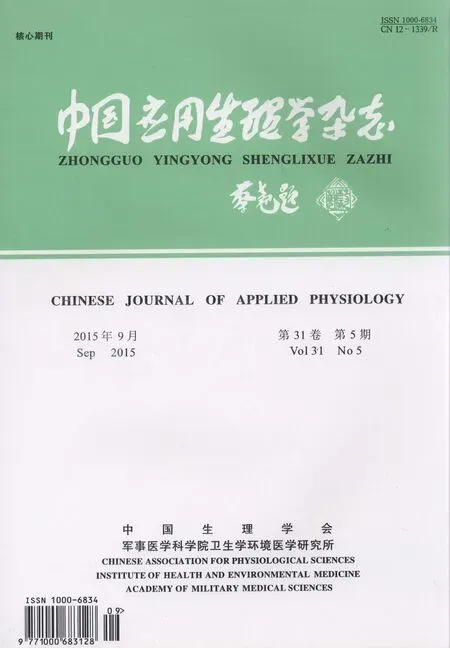中老年高血压患者脉压与动脉粥样硬化性肾动脉狭窄的关系*
江 瑛, 麻玉秀, 刘宏斌, 朱 兵, 王 亮
(中国人民解放军总医院南楼心血管内科, 北京 100853)
中老年高血压患者脉压与动脉粥样硬化性肾动脉狭窄的关系*
江 瑛, 麻玉秀, 刘宏斌△, 朱 兵, 王 亮
(中国人民解放军总医院南楼心血管内科, 北京 100853)
目的:探讨中老年高血压患者脉压与动脉粥样硬化性肾动脉狭窄(ARAS)关系,为临床ARAS的诊治提供新的思路。方法:回顾性分析257例行肾动脉造影的中老年高血压患者资料,平均年龄 (64.09±7.81) 岁,按造影结果分ARAS 组(n=145)与非ARAS组(n=112),对其脉压及多项与ARAS高度相关的临床指标进行统计分析。结果:单因素的相关分析显示:年龄、脉压、血肌酐水平、50岁以后出现的高血压与ARAS相关。四项变量均进入回归方程,并与ARAS呈正相关,其中年龄、脉压与血肌酐是一连续变量。结论:脉压是中老年高血压患者动脉硬化性肾动脉狭窄的新发危险因素,是中老年高血压患者ARAS发病的早期预测指标,也是ARAS治疗的又一药物治疗靶。
脉压;动脉粥样硬化性肾动脉狭窄;高血压
高血压是中老年人最常见的疾病之一,部分表现为脉压差增大,临床工作中发现该部分患者往往伴有不同程度的动脉粥样硬化性肾动脉狭窄(atherosclerotic renal artery stenosis, ARAS),但尚无确切的临床研究。一项尸解调查资料显示报道,在大于40岁的心脑血管病患者中,ARAS的比例达12%[1]。ARAS不仅可导致继发性高血压和终末期肾病,而且其死亡率显著上升,预后甚至与结肠癌类似[2]。由于ARAS起病隐匿、进展迅速,所以早期发现肾动脉狭窄,适时干预,对中老年高血压的控制及减少心脑血管事件有重要意义。本文目的是探讨中老年高血压患者脉压与ARAS的关系,为中老年高血压的诊治及肾动脉狭窄的防治提供理论依据。
1 材料与方法
1.1 研究对象
2009年10月至2014年10月解放军总医院行非选择性肾动脉造影、年龄大于40岁的中老年高血压患者257例,平均年龄 (64.09±7.81) 岁,ARAS组 145人,非ARAS组112人。
1.2 高血压诊断标准
血压测量采用校正的汞柱式血压计, 测量前至少休息 5 min, 不讲话, 测 2 次坐位右上臂肱动脉血压,测量时肘关节与心脏处同一水平, 以 Kroto koff第 1 音为收缩压, 第 5 音为舒张压, 两次测量间隔至少 2 min, 取平均值。脉压=收缩压-舒张压。所有血压测量医护人员皆经过正规培训。根据JNC制订的诊断标准,收缩压≥140 mmHg和(或)舒张压≥90 mmHg 诊断高血压。
1.3 ARAS诊断标准
有动脉粥样硬化的危险因素,且肾动脉造影示肾动脉狭窄≥50%,病变位于开口处或近端,呈偏心性,边缘不整。排除 (1)大动脉炎:病史中曾有结核、链球菌感染、风湿或结缔组织病史;有血沉、C-反应蛋白、白细胞计数、免疫球蛋白增高的化验检查资料,有大动脉炎相关的多部位动脉狭窄表现;(2)纤维肌性发育不良:病变位于肾动脉主干中远段,狭窄呈串珠样。
1.4 临床观察指标
除脉压以外,同时我们筛选了与ARAS高度相关的危险因素:年龄、性别、体重指数、吸烟史(分为从未吸烟或有吸烟史)、脉压、血甘油三酯(triglycerides,TG)、血总胆固醇(total cholesterol, TC)、血肌酐水平、糖尿病病史、心肌梗塞病史、脑卒中病史、50岁以后出现的高血压及顽固性高血压。
1.5 统计学处理
2 结果
2.1 Logistic单因素分析结果
两组人群年龄、性别、动脉粥样硬化的危险因素(包括吸烟史、糖尿病、脂代谢紊乱)、心脑血管疾病及血压水平均无统计学差异。单因素的相关分析显示年龄、脉压、血肌酐水平与ARAS相关(表1)。
2.2 Logistic多因素分析结果
在单因素分析的基础上,我们选取与ARAS相关的四个变量:年龄、脉压、血肌酐、50岁以后出现的高血压,代入多因素回归方程(Enter 法),并应用Good-Fitness进行检验。结果显示:四项变量均进入方程(表2)。年龄、脉压、血肌酐、50岁以后出现高血压这四个变量均可进入回归方程,并呈正相关,其中年龄、脉压与血肌酐Wald χ2值较大,作为连续变量,50岁以后出现高血压是首要的危险因素。
3 讨论
ARAS在中老年人群的发病较普通人群明显升高[3]。早在2005年ACC/AHA颁布的指南就提出,55岁后出现的严重的高血压、高血压突然加重、顽
Tab. 1 Single factor correlation analysis: relativity between clinical indexes and ARAS(P<0.05)

clinicalin-dexesARASNon-ARASAge(years)69.44±8.1962.50±8.76**Man:Femal1.88∶11.03∶1BMI(kg/m2)24.08±2.3723.63±2.43Smoking(%)21.713.5PP(mm-Hg)57.6±9.743.3±11.1**TC(mmol/L)5.53±0.805.29±1.03TG(mmol/L)2.63±1.912.38±2.13SCr(umol/L)96.83±28.4081.45±25.67**DM(%)52.238.5Stroke(%)21.721.7MI(%)13.09.4New-onsethypertension(%)73.9 43.9**RAH(%)21.710.7
ARAS: Atherosclerotic renal artery stenosis; BMI: Body mass index; PP: Pulse pressure; TC: Total cholesterol; TG: Blood triglyceride; SCr: Serum creatinine; DM: Diabetes mellitus; MI: Miocardial infarction; RAH: Resistant arterial hypertension; New-onset hypertension: New onset of hypertension after 50 years of age**P<0.01vsARAS group
Tab. 2 Multivariate Logisitic regression analysis for ARAS variable

ARASvari-ableβWaldχ2POR95%CIAge(years)0.05612.2610.0331.0601.017-1.443PP(mm-Hg)0.03215.3630.0211.0331.005-1.061SCr(umol/L)0.01414.6290.0001.0151.001-1.028New-onsetHyperten-sion0.61411.2260.0281.8481.623-2.878Constant-2.8844.0970.0430.056
ARAS: Atherosclerotic renal artery stenosis; OR: Odds ratio; PP: Pulse pressure; SCr: Serum creatinine; New-onset hypertension: New onset of hypertension after 50 years of age
固性高血压、恶性高血压、服用ACEI/ARB后血肌酐升高、B超示不明原因两侧肾脏长径相差1.5 cm以上、不明原因的肾功能不全为主要ARAS的临床主要诊断线索[4]。可见本研究显示年龄、血肌酐、50岁以后出现高血压与中老年高血压患者ARAS发病呈正相关,这与临床是相符的。
值得关注的是,脉压作为新的变量出现在我们的研究中。在最初ARAS的研究中,脉压未被引起重视。随着人们对动脉粥样硬化病理生理的深入了解,脉压已被公认为是全身动脉粥样硬化的预测指标,已被证实与冠状动脉粥样硬化、颈动脉粥样硬化高度相关。301医院最新的一项大型研究指出脉压数是动脉粥样硬化的重要诊断指标[5]。更为重要的是,在双侧ARAS的患者中,脉压较同年龄无ARAS的患者平均增高23 mmHg[6]。而且脉压的增高可能提示ARAS病人对介入治疗的效果不佳[7]。
本研究显示在中老年高血压患者ARAS发病中,年龄、脉压、肌酐是一连续变量,那么脉压在ARAS的发病中扮演何种角色呢?基础研究显示:宽脉压(脉压≥60 mmHg)增加动脉的牵拉,血管壁所受压力增大,易使内膜损伤而导致动脉粥样硬化[8]。事实上,脉压随年龄的增加而增加,因为年龄与主动脉及主要血管弹力丧失有关,动脉弹力层断裂和损坏及胶原蛋白和弹力蛋白比例改变导致的大动脉,特别是主动脉僵硬度增加。由于动脉退行性病变使脉压增加,这是动脉粥样硬化的开始阶段,可由此引起进一步的、反复的动脉壁损害。小血管用乙酰胆碱活性评价法检测也表明,脉压增高致内皮细胞功能紊乱,内皮细胞功能紊乱是动脉粥样硬化的先兆。那么,脉压增高使肾动脉粥样硬化增加导致ARAS,ARAS可引起缺血性肾病和肾性高血压。可见,本研究显示的四项变量是与基础研究相符的,并且在这一连续变量中,脉压增加是疾病的起源。
最近也有另一种解释[9]:脉压增高具有双重性,即脉压既是动脉粥样硬化的原因,也是动脉粥样硬化的结果。主动脉僵硬度增加将增加心脑血管的不良事件,也提示了脉压增高的ARAS患者介入治疗效果不佳的可能原因。
最新报道[10],约有20%~50%的ARAS病人并无明显的临床表现。ARAS一旦发病,进展快但又是可治的,纠正ARAS后,部分病例不仅能纠正高血压,而且能保护受损的肾功能,使ARAS成为少有的中老年人高血压和慢性肾功能不全的可治性病因之一。因此本病的早期发现是关键。在本研究所得的四项变量中,无论从动脉粥样硬化的原因还是结果来分析,脉压是核心,是重要的危险因素。因此脉压值是中老年高血压患者ARAS发病的早期预测指标,也是ARAS治疗的又一药物治疗靶。
[1] Fujii H, Nakamura S, Kuroda S,etal. Relationship between renal artery stenosis and intrarenal damage in autopsysubjects with stroke [J].NephrolDialTransplant, 2006, 21(1): 113-119.
[2] Barker E, Desmukh H, Levin D,etal. 9C.02: EFFECT OF DIFFERENT ANTIHYPERTENSIVE DRUG CLASSES ON SURVIVAL IN UNILATERAL AND BILATERAL RENAL ARTERY STENOSIS: A RETROSPECTIVE RECORD-LINKAGE STUDY [J].JHypertens, 2015, 33(Suppl 1): e123.
[3] Peng M, Jiang XJ, Dong H,etal. Etiology of renal artery stenosis in 2047 patients: a single-center retrospective analysis during a 15-year period in China[J].JHumHypertens, 2015, (7).
[4] Hirsch AT, Haskal ZJ, Hertzer NR,etal. ACC/AHA 2005 practice guidelines for the management of patients with peripheral arterial disease (lower extremity, renal, mesenteric, and abdominal aortic): a collaborative report from the American Association for Vascular Surgery/Society for Vascular Surgery, Society for Cardiovascular Angiography and Interventions, Society for Vascular Medicine and Biology, Society of Interventional Radiology, and the ACC/AHA Task Force on Practice Guidelines (writing committee to develop guidelines for the management of patients with peripheral arterial disease): endorsed by the American Association of Cardiovascular and Pulmonary Rehabilitation; National Heart, Lung, and Blood Institute; Society for Vascular Nursing; TransAtlantic Inter-Society Consensus; and Vascular Disease Foundation [J].Circulation, 2006, 113 (11): e463-654.
[5] Zheng Y, Li Z, Shu H,etal. Relationship between sum of the four limbs'pulse pressure and brachial-ankle pulse wavevelocity and atherosclerosis risk factors in Chinese adults [J].BiomedResInt, 2015: 434516.
[6] Lee Y, Shin JH, Park HC,etal. A prediction model for renal artery stenosis using carotid ultrasonography measurements in patients undergoing coronary angiography[J].BMCNephrol, 2014, 15: 60.
[7] Yildiz M, Carl Aykan A, Karakoyun S,etal. Clinical outcomes and effectiveness of renal artery stenting in patients with critical atherosclerotic renal artery stenosis: does it improve blood pressure control and renal function assessed by estimated glomerular filtration rate[J].PostepyKardiolInterwencyjnej, 2013, 9(3): 228-233.
[8] Textor SC, Lerman L. Renovascular hypertension and ischemic nephropathy[J].AmJHypertens, 2010, 23(11): 1159-1169.
[9] Jankowski P, Czarnecka D. Pulse pressure, blood flow, and atherosclerosis[J].AmJHypertens, 2012, 25(10): 1040-1041.
[10]Jenkins TL, Baker MG, Baheti AR,etal. Outcomes of hypertensive patients with renal fibromuscular dysplasia compared with patients with concomitant atherosclerotic renal artery stenosis following endovascular therapy [J].JVascIntervRadiol, 2015, 26(5): 625-633.
Relationship between pulse pressure and atherosclerotic renal artery stenosis in middile-aged and elderly patients with hypertension
JIANG Ying, MA Yu-xiu, LIU Hong-bin△, ZHU Bing, WANG Liang
(Department of Cardiology of South Building, General Hospital of PLA, Beijing 100853, China)
Objective: To analyze the relationship between the pulse pressure(PP) and atherosclerotic renal artery stenosis (ARAS) in middile-aged and elderly patients with hypertension, so as to provide the basis for the diagnosis and treatment of ARAS. Methods: We retrospectively analyzed the data of 257 patients with hypertension undergoing renal arteriography at General Hospital of PLA between 2009 and 2014. Their mean age was (64.09±7.81) years. According the results of arteriography, they were divided into two groups: ARAS group (n=145), and non-ARAS group (n=112). Their PP and multinomial clinical indexes with ARAS were statistically analyzed. Results: Single factor correlation and Logisitic analysis showed that age, PP, serum creatinine (SCr) levels, and new onset of hypertension after 50 years of age were strongly positively related to ARAS. The age and PP and SCr was a team of continuous variable. Conclusion: PP was the first new risk factor of ARAS in middile-aged and elderly patients with hypertension. It is suggested that PP may be a early predictive indicator and a new therapeutic target for ARAS.
pulse pressure; atherosclerotic renal artery stenosis; hypertension
2015-04-07
2015-06-06
R443.5
A
1000-6834(2015)05-452-03
10.13459/j.cnki.cjap.2015.05.017
△【通讯作者】Tel: 13910669681; E-mail: liuhbin301@sohu.com

